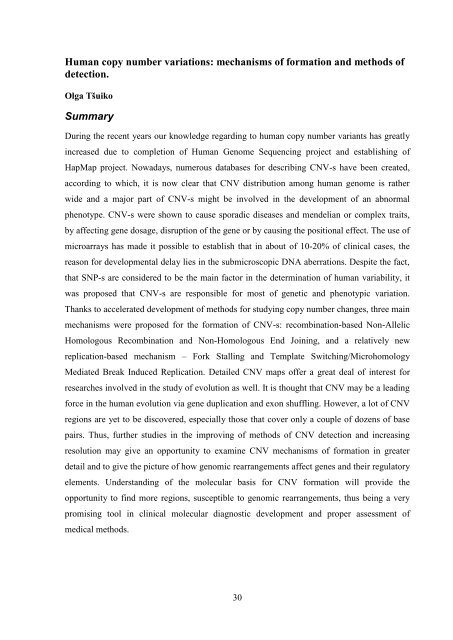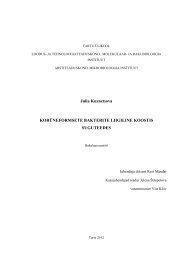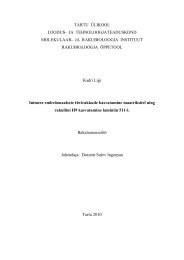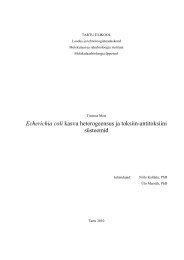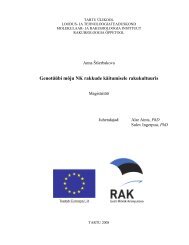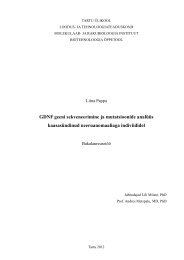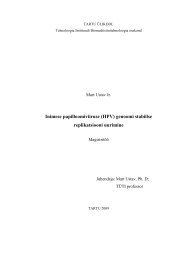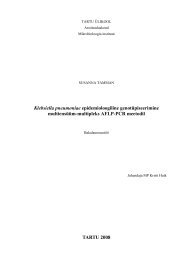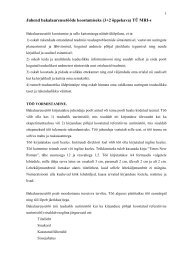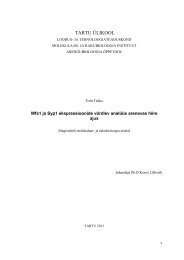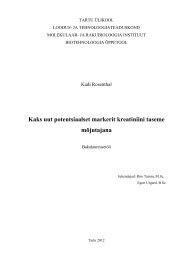Inimese DNA koopiaarvu variatsioonid: nende tekkemehhanismid ja ...
Inimese DNA koopiaarvu variatsioonid: nende tekkemehhanismid ja ...
Inimese DNA koopiaarvu variatsioonid: nende tekkemehhanismid ja ...
Create successful ePaper yourself
Turn your PDF publications into a flip-book with our unique Google optimized e-Paper software.
Human copy number variations: mechanisms of formation and methods of<br />
detection.<br />
Olga Tšuiko<br />
Summary<br />
During the recent years our knowledge regarding to human copy number variants has greatly<br />
increased due to completion of Human Genome Sequencing project and establishing of<br />
HapMap project. Nowadays, numerous databases for describing CNV-s have been created,<br />
according to which, it is now clear that CNV distribution among human genome is rather<br />
wide and a major part of CNV-s might be involved in the development of an abnormal<br />
phenotype. CNV-s were shown to cause sporadic diseases and mendelian or complex traits,<br />
by affecting gene dosage, disruption of the gene or by causing the positional effect. The use of<br />
microarrays has made it possible to establish that in about of 10-20% of clinical cases, the<br />
reason for developmental delay lies in the submicroscopic <strong>DNA</strong> aberrations. Despite the fact,<br />
that SNP-s are considered to be the main factor in the determination of human variability, it<br />
was proposed that CNV-s are responsible for most of genetic and phenotypic variation.<br />
Thanks to accelerated development of methods for studying copy number changes, three main<br />
mechanisms were proposed for the formation of CNV-s: recombination-based Non-Allelic<br />
Homologous Recombination and Non-Homologous End Joining, and a relatively new<br />
replication-based mechanism – Fork Stalling and Template Switching/Microhomology<br />
Mediated Break Induced Replication. Detailed CNV maps offer a great deal of interest for<br />
researches involved in the study of evolution as well. It is thought that CNV may be a leading<br />
force in the human evolution via gene duplication and exon shuffling. However, a lot of CNV<br />
regions are yet to be discovered, especially those that cover only a couple of dozens of base<br />
pairs. Thus, further studies in the improving of methods of CNV detection and increasing<br />
resolution may give an opportunity to examine CNV mechanisms of formation in greater<br />
detail and to give the picture of how genomic rearrangements affect genes and their regulatory<br />
elements. Understanding of the molecular basis for CNV formation will provide the<br />
opportunity to find more regions, susceptible to genomic rearrangements, thus being a very<br />
promising tool in clinical molecular diagnostic development and proper assessment of<br />
medical methods.<br />
30


